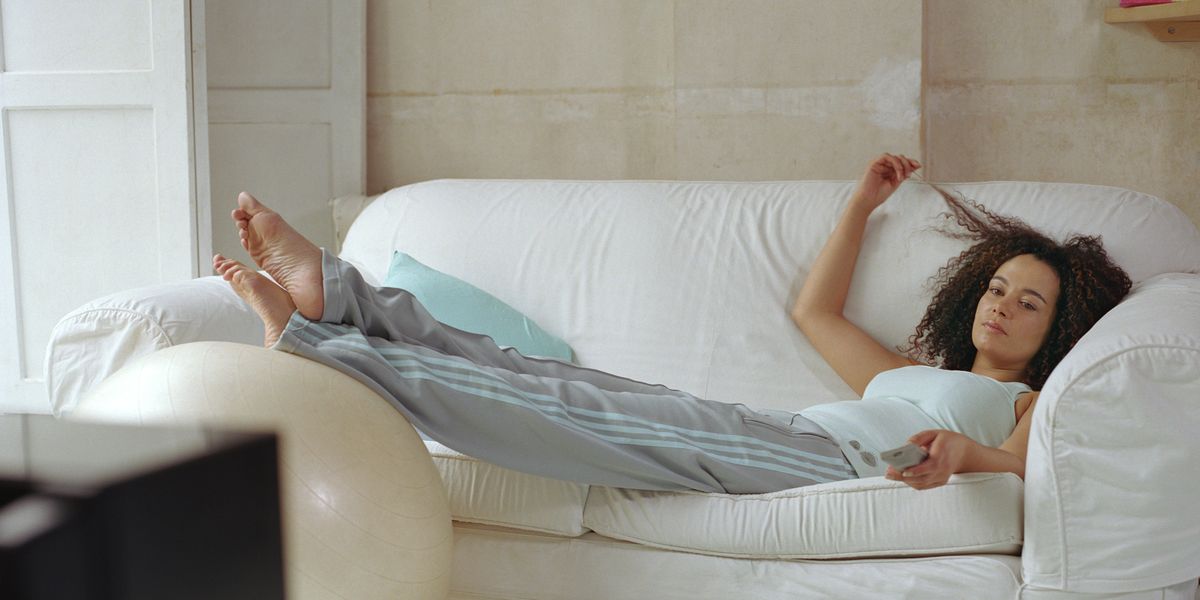The day before my half-marathon, I barely left my couch. Instead of doing a shakeout run to get my blood circulating and prep my body for the race, I opted to scroll on socials, watch How To Lose A Guy In Ten Days, and hydrate. Turns out, a couch rot day was exactly what I needed—I woke up refreshed, relaxed, and ready to crush 13 miles.
For anyone with a fitness goal—whether it’s running a race, building muscle, or improving strength—taking a day off (like, really off) might feel like it’s sabotaging your progress. But rest days are totally necessary for your body and mind to recover and return to your workouts feeling stronger than ever, says Enna Selmanovic, CPT, a trainer at Crunch Fitness in New York.
So, is it okay to spend your rest day with your butt glued to the couch? Ahead, trainers break down everything to know about couch rot days, including when and how to have one.
Meet the experts: Enna Selmanovic, CPT, is a trainer at Crunch Fitness in New York. Gab Reznik, CPT, is the head coach at Tone House.
Passive Vs. Active Recovery
There are two types of rest days: a passive recovery day (where you do absolutely nothing and veg on your couch or in your bed!) and an active recovery day. With active recovery, you’re still getting movement in, just keeping it low intensity. (Think: going for a walk, stretching, foam rolling, or swimming easy laps in the pool.) Active rest promotes blood circulation, reduces muscle soreness, and supports recovery without adding any extra strain to the body, says Selmanovic.
Passive recovery obviously won’t get the blood flowing, but since you’re giving your body a break, it helps muscle repair and energy recuperation, Selmanovic says. However, most of the benefits that come from a true rest day are mental, as taking an intentional pause can help your brain reset. “It can honestly be a restorative act of self-kindness to say, ‘I don’t have to be productive to deserve rest today,’” she says. Plus, if you’re overworking yourself—either in life or at the gym—a rest day can break up your schedule and help prevent burnout.
How bad are passive recovery days for you?
One couch rot day, once in a while, really isn’t going to impact your health negatively, Selmanovic says. You won’t lose strength, muscle, or endurance gains, and your cardiovascular health won’t be harmed. In fact, “sometimes you need it,” she adds.
There are some drawbacks worth considering, though. “While you’re staying off your feet for the day, restricting yourself to the couch will lead to a day of poor blood circulation, muscle stiffness, and lack of endorphin release,” says Gab Reznik, CPT, head coach at Tone House. (She reserves full rest days for after an extremely taxing day on the body, like post-marathon, where her heart rate was highly elevated for an extended period of time or her central nervous system was very active.)
Really, the potential problem with true rest days is just how frequently you take them. “Once a week, we need a day” to completely unwind, says Selmanovic. Reznik is a little more conservative, offering one to two times per month. While “active recovery will always be better for you” than sitting on the couch all day, take the rest if you need it, Selmanovic says.
Whether you choose to take a full rest day or an active recovery day is completely up to you and how you feel—just listen to your body.
How To Add Movement Into A Passive Recovery Day
FWIW, it doesn’t take a lot to add some active recovery work into your day—you don’t even need to leave your living room. You can do stretches, foam rolling, and simple mobility exercises right from your couch if you want, says Selmanovic.
You can also go on a walk. “Getting some fresh air, even if that means a 30-minute walk around your neighborhood, can do wonders for your mental and physical stimulation,” says Reznik. It actually only takes 15 to 30 minutes of light movement to get some of those active recovery benefits, such as improving blood circulation and muscle soreness, she says.
And who knows? You might feel better than you would’ve if you’d never left that couch.
Olivia Luppino is an editorial assistant at Women’s Health. She spends most of her time interviewing expert sources about the latest fitness trends, nutrition tips, and practical advice for living a healthier life. Olivia previously wrote for New York Magazine’s The Cut, PS (formerly POPSUGAR), and Salon, where she also did on-camera interviews with celebrity guests. She’s currently training for the New York City marathon.
Read the full article here




